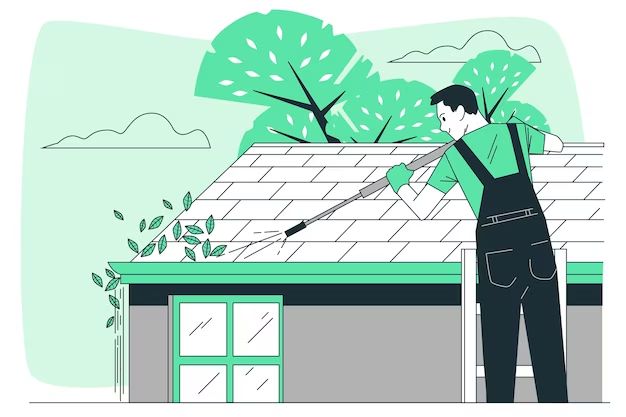Cleaning roofs can be a challenging task, especially for homeowners without professional equipment and experience. Hiring a professional roof cleaning company is often the best option, as they have the proper tools, chemicals, and techniques to safely and effectively clean different types of roofs. However, if you want to take on the project yourself, it’s important to understand what equipment the professionals use so you can get the job done right.
Page Contents
Safety Equipment
The first priority for professional roof cleaners is safety. Working at heights on sloped and slippery surfaces requires proper fall protection and precautions. Here are some essential safety tools the pros use:
- Roofing harnesses – Roofers wear specially designed safety harnesses with a lanyard or rope grab system attached to anchor points on the roof. This allows full mobility while preventing falls.
- Shoes with grip – Thick, lugged rubber outsoles provide traction on shingles.
- Gloves – Durable gloves protect hands from chemical cleaning solutions and abrasive roofing materials.
- Goggles – Eye protection is a must when working with chemicals. Goggles keep cleaning solutions from splashing into the eyes.
- Hard hats – Roof cleaners wear hard hats to protect against falling debris and accidental bumps into roof vents or overhangs.
Using proper safety gear greatly reduces the risk of slips, falls, and injuries when working on roofs.
Low Pressure Washers
The primary piece of cleaning equipment professionals use is a power washer. However, high pressure washers used for cleaning driveways or house siding can damage shingles and lead to leaks. Low pressure systems provide just enough cleaning power to remove dirt and grime without damaging roofing materials. Key features of effective roof cleaning pressure washers include:
- PSI under 1500 – Keeping water pressure below 1500 PSI is ideal for roof cleaning.
- Wide spray nozzles – Fan spray tips distribute water evenly and cover more surface area.
- Long hoses – Hoses at least 50 ft long allow roof cleaners to access all areas of the roof safely.
- Handheld wands – Wands give precise control for targeted cleaning of dirty spots.
Look for systems in the 1000 to 1500 PSI range from reputable power washer brands designed specifically for roof cleaning tasks.
Soft Wash Chemicals
While low pressure rinsing removes loose dirt, specialized chemicals help dissolve and lift away stubborn stuck-on grime. Roof cleaning pros often use:
- Sodium hypochlorite (bleach) – Bleach-based cleaners are effective and affordable for cleaning discoloration on lighter roofing types like concrete or clay tiles.
- Sodium hydroxide (lye) – Also called caustic soda, lye breaks down dark stained matter on asphalt composite shingles.
- Trisodium phosphate (TSP) – TSP removes oily deposits, mildew stains, and chalky buildup on a variety of roofing materials.
- Hydrogen peroxide – Useful for removing moss and lichens, hydrogen peroxide also brightens roofing.
The right chemical cleaning agents used properly dissolve stubborn stains without degrading or discoloring the roof. Roofing pros carefully evaluate each roof to determine the best cleaning solutions.
Scrub Brushes & Scrapers
Soft washing alone won’t remove all debris and growth from roofs with significant buildup. Professionals use the following hands-on tools in combination with power washing:
- Scrub brushes – Stiff nylon or natural fiber brushes agitate dirt and stains.
- Push brooms – Sweeping debris and moss before washing prevents clogging drains or gutters.
- Shovels – Shovels remove packed leaves, branches, and other debris.
- Scrapers – Flexible plastic, wood, or metal scrapers pry off lichens and moss clinging to shingles.
The physical scrubbing and scraping loosens stubborn gunk so chemicals and water can wash it away cleanly.
Moss Prevention Treatments
Once the roof cleaning is complete, pros often apply a protective moss prevention treatment. Zinc or copper strips installed along ridges and edges help inhibit moss regrowth.Liquid moss inhibitors containing zinc sulfate or sodium dichlor also deter moisture and moss. By proactively preventing moss after cleaning, the roof stays cleaner longer.
Conclusion
Cleaning roofs requires the right mix of specialized gear for safety, soft washing, scrubbing, and moss prevention. While DIY roof cleaning is possible, pros have the experience to properly evaluate each roof and choose effective cleaning solutions that won’t damage the roof. Investing in professional roof cleaning protects the integrity of your roofing materials while restoring curb appeal and home value.
